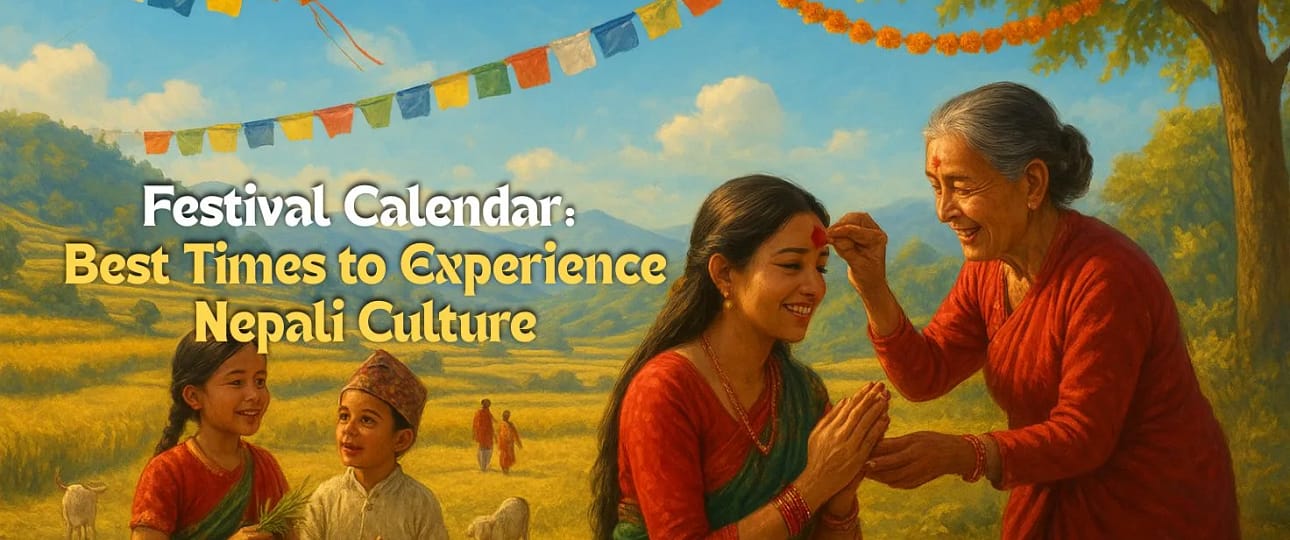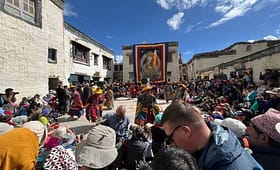Alright, Best Times to Experience Nepali Culture: let’s be real for a sec. You can totally plan your little Everest Base Camp hike around postcard-perfect skies and Insta-worthy views. Go nuts. But if you’re actually trying to feel Nepal, not just see it, you gotta hit those trails when the villages are straight-up. I’m talking wild bursts of color, music blaring, everyone losing their minds in the best possible way. That’s the good stuff, right there.
So, Why Bother Trekking During Festival Season?
Simple math, my friend: Mountains + culture = your brain does a backflip. Hiking in Nepal when everyone’s in full celebration mode is a whole different game. Suddenly, you’re not just some rando strolling past sleepy villages. You’re smack in the middle of centuries-old traditions, getting swept into the chaos. The lady at the tea house isn’t just handing you dal bhat and shuffling off. She’s dragging you into the kitchen to try festival treats still warm from the stove, probably made by her grandma. And those Sherpa guides?
Look, sure, you might run into some extra crowds, or find out your go-to lodge is shut ’cause everyone’s busy dancing or whatever. But honestly, who cares? You didn’t come all this way just to stare at mountains in silence, did you? Go when Nepal’s alive. Let it knock your socks off.
Dashain (September/October) – When Everyone Collectively Loses It

Okay so Dashain is basically Nepal throwing the mother of all parties for fifteen days straight. Think Christmas energy meets Thanksgiving vibes, toss in New Year’s chaos, and boom. Dashain. Usually hits late September or October, right when autumn trekking season is firing on all cylinders.
If you’re stomping around the Annapurna Base Camp trek or grinding up the Langtang Valley during Dashain, first thing you’ll notice: everyone’s bailing. Your porter? Dude’s asking for time off to see his fam. That guy running the tea house in Namche? His entire extended family just rolled in from who-knows-where. It’s this massive homecoming thing, and honestly, it’s beautiful in a chaotic way.
The official story is it celebrates some goddess named Durga kicking evil’s butt, but what you’ll actually witness is people decked out in their absolute finest threads, swinging on these insane bamboo swings that look one gust of wind away from disaster, and families gathering for feasts that’d make your head spin. If you’re trekking Everest region trails during Dashain, don’t be shocked when your guide’s like “yo, come to my village for tika.” That’s the red powder-rice blessing elders slap on your forehead. Good luck for your trek, supposedly. You’ll need it before tackling Cho La Pass or whatever madness you signed up for.
Trails like Manaslu Circuit or the classic Poon Hill trek? Absolutely stunning during Dashain because monsoon just wrapped, everything’s ridiculously green, and those autumn colors are starting to pop. Plus the mountains are stupid-clear after all that rain washed the haze away.
Tihar (October/November) – Lights, Dogs, and Straight-Up Magic
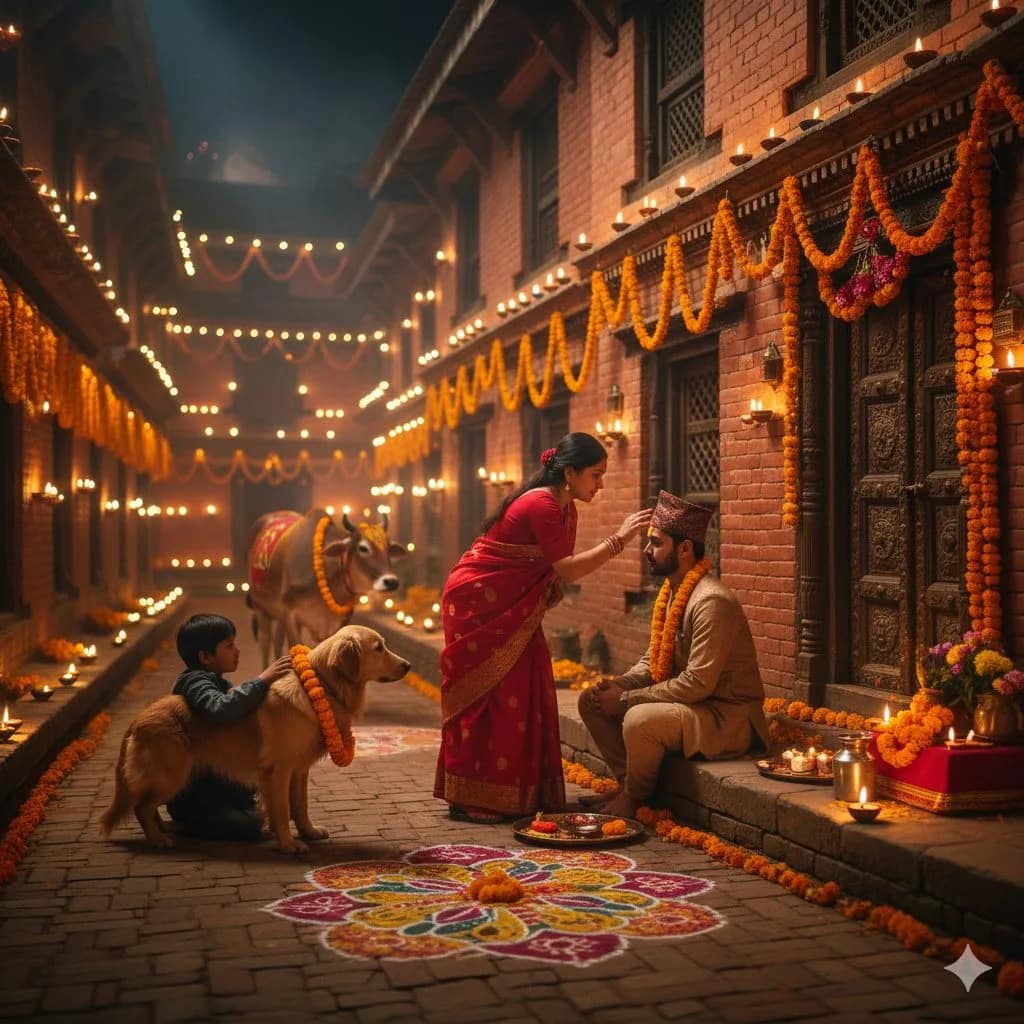
Right after Dashain, Nepal immediately rolls into Tihar, and man, this one hits different. It’s the Festival of Lights, five days of basically celebrating everything—crows, dogs, cows, your siblings, you name it. Yeah, there’s literally a whole day just for dogs. Let that sink in.
If you’re doing the Ghorepani Poon Hill trek or messing around Pokhara on shorter routes during Tihar, villages transform into these glowing wonderlands. Every house, every tea house, every monastery gets covered in oil lamps and marigold flowers. Walking mountain trails at night feels like someone dumped a million fireflies everywhere and told them to get their act together.
Day two is Kukur Tihar (dog day) and it’s exactly as wholesome as you’re imagining. Every dog, from the scrappy Thamel street mutts to those massive Tibetan mastiffs guarding high-altitude villages, gets flower garlands, tika, and special snacks. You’re trekking and suddenly spot dogs wearing flower necklaces looking smug as hell? That’s why.
For folks grinding out longer hauls like Everest Base Camp or the wild Upper Mustang trek, Tihar means Deusi and Bhailo. These traditional singing crews going house to house. It’s loud, it’s joyful, and if you’re crashed at a village tea house, someone’s definitely yanking you into the dancing whether you know the moves or not. Spoiler: you don’t, and nobody cares.
Losar (February) – Tibetan New Year When It’s Cold As Hell

Now we’re talking festivals you only catch if you’re trekking high-altitude spots with serious Tibetan Buddhist vibes. Losar is Tibetan New Year, massive in the Everest region, Langtang, Manaslu, and especially Upper Mustang.
February’s winter trekking territory, so trails are emptier and way colder, but if you can handle snow and temperatures that’ll freeze your face off, experiencing Losar in Namche Bazaar or Lo Manthang is totally worth it. We’re talking monastery ceremonies with monks rocking elaborate costumes doing these masked dances called Cham. Butter tea flowing like water, momos being cranked out by the hundreds, and chang—local barley beer that’ll warm you up faster than your fancy down jacket ever could.
Sherpa communities go hard for Losar. If you’re on the Gokyo Lakes trek or Three Passes trek around this time, you might score an invite to a local home where they’re serving khapse, these twisted fried pastries that honestly look too pretty to eat. Fair warning though: the village elders will keep topping off your chang glass, and saying no is basically insulting them. Pace yourself or prepare to regret life choices.
But Losar’s not just a party, it’s deeply spiritual, you know? Sherpa families cleaning their homes like their lives depend on it, hitting up monasteries for prayers, burning juniper branches to purify everything for the new year. If you’re trekking to Everest Base Camp or tackling the Manaslu Circuit during Losar, expect trail delays because yeah, people actually take time off to celebrate properly. As they should.
Holi (March) – Color Chaos Invades the Trails

Holi is that festival where rules completely cease to exist and everyone just pelts each other with colored powder. It’s messy, it’s insane, and if you’re trekking Nepal in March, you’re not escaping it. Trust me, I’ve tried.
Lower elevation treks like Poon Hill, Mardi Himal trek, or Pikey Peak are perfect during Holi ’cause you’re rolling through villages right when the madness kicks off. Kids will straight-up ambush you with colored powder. Your trekking gear? Say goodbye to its original color. Your guide will be laughing way too hard to give you any kind of heads-up.
In Kathmandu, Thamel becomes an absolute war zone of color. If you’re starting or finishing your Annapurna Base Camp trek around Holi, just accept that your backpack’s getting tie-dyed whether you like it or not.
The beautiful thing about Holi on the trails is it completely erases all barriers. Nobody cares if you’re some foreign trekker or a local kid—if you’re in range, you’re getting colored. It’s this gorgeous, chaotic equalizer where everyone’s just cracking up and covered in rainbow dust.
Buddha Jayanti (April/May) – Peace in the Middle of Your Suffering
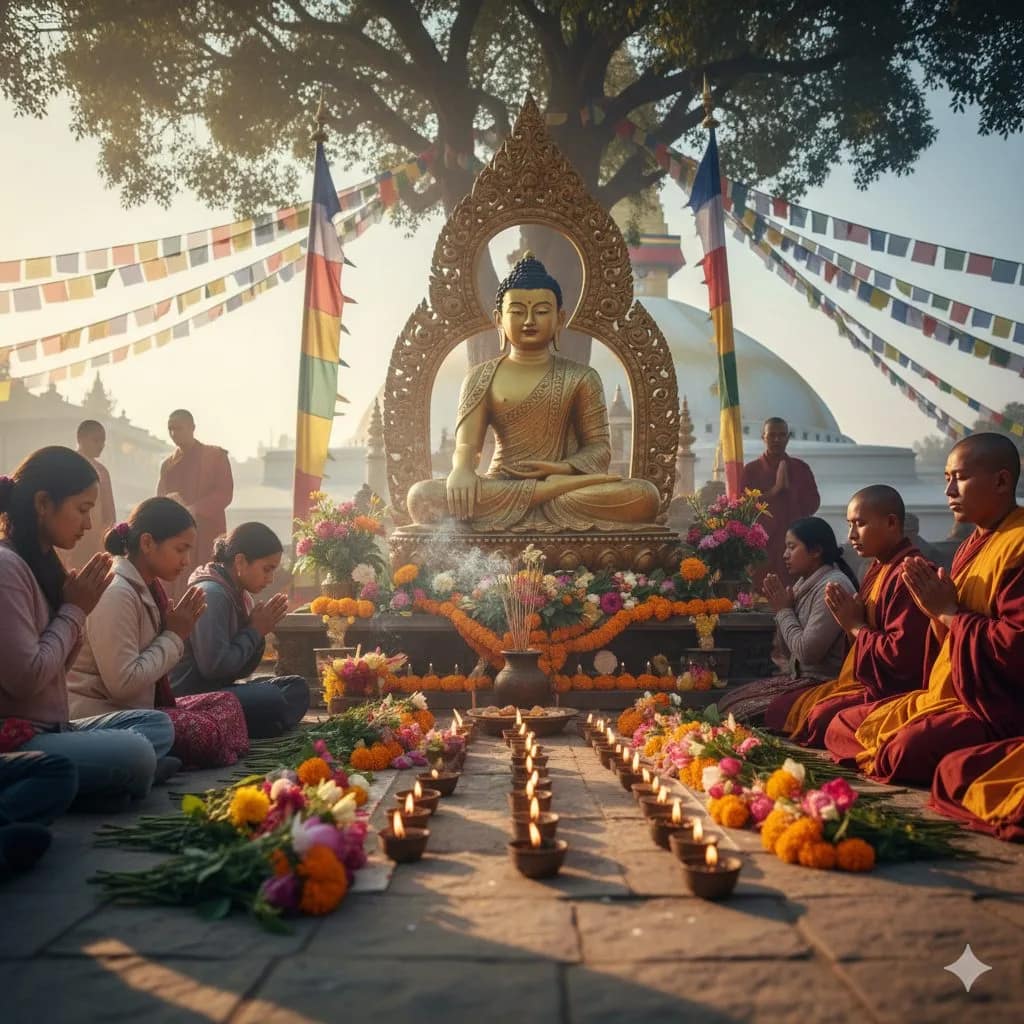
Buddha Jayanti celebrates Lord Buddha’s birth, and for trekkers it means witnessing something incredibly peaceful while you’re dying from exhaustion on some uphill grind. Monasteries along routes like Everest Base Camp, Langtang trek, and Annapurna Circuit light up with butter lamps, and there’s these special prayer ceremonies happening.
If you’re trekking through Buddhist regions in April or May, you’ll see fresh prayer flags going up, monastery courtyards packed with monks chanting, and pilgrims walking kora—that’s circumambulation, going in circles around sacred sites. Tengboche Monastery in the Everest region or Kyanjin Gompa in Langtang? Absolutely atmospheric during Buddha Jayanti.
It’s spring trekking season, so rhododendron forests are blooming like they’re showing off, and mixed with the spiritual festival vibes, it’s honestly one of the best times to trek Nepal. Weather’s stable, views are sharp, and there’s this sense of calm that somehow makes those brutal uphill sections feel almost meditative. Almost.
Mani Rimdu (October/November) – The Festival Serious Trekkers Geek Out Over
Okay, this one’s special for real trekkers. Mani Rimdu is a Sherpa Buddhist festival happening at monasteries in the Everest region, mainly Tengboche and Chiwong. It’s not as famous as Dashain or Tihar, but for people doing the Everest Base Camp trek, catching Mani Rimdu is like hitting the cultural jackpot.
The festival features these elaborate masked dances by monks, telling stories about Buddhism stomping out the old Bon religion. These aren’t performances, they’re sacred rituals passed down for generations. The costumes are insane—hand-sewn, decorated with ridiculous detail—and the masks are these terrifying yet beautiful representations of protective deities.
If you’re on the Everest Base Camp trek or Gokyo Lakes route in late October or November, time it so you hit Tengboche during Mani Rimdu. You’ll be sitting in a monastery courtyard at 3,860 meters, surrounded by the world’s highest peaks, watching monks perform dances that are equal parts spiritual ceremony and theatrical madness. Plus, the entire Sherpa community rolls out for this, so there’s this incredible sense of everyone being in it together.
Teej (August/September) – Women’s Festival When Monsoon’s Still Doing Its Thing
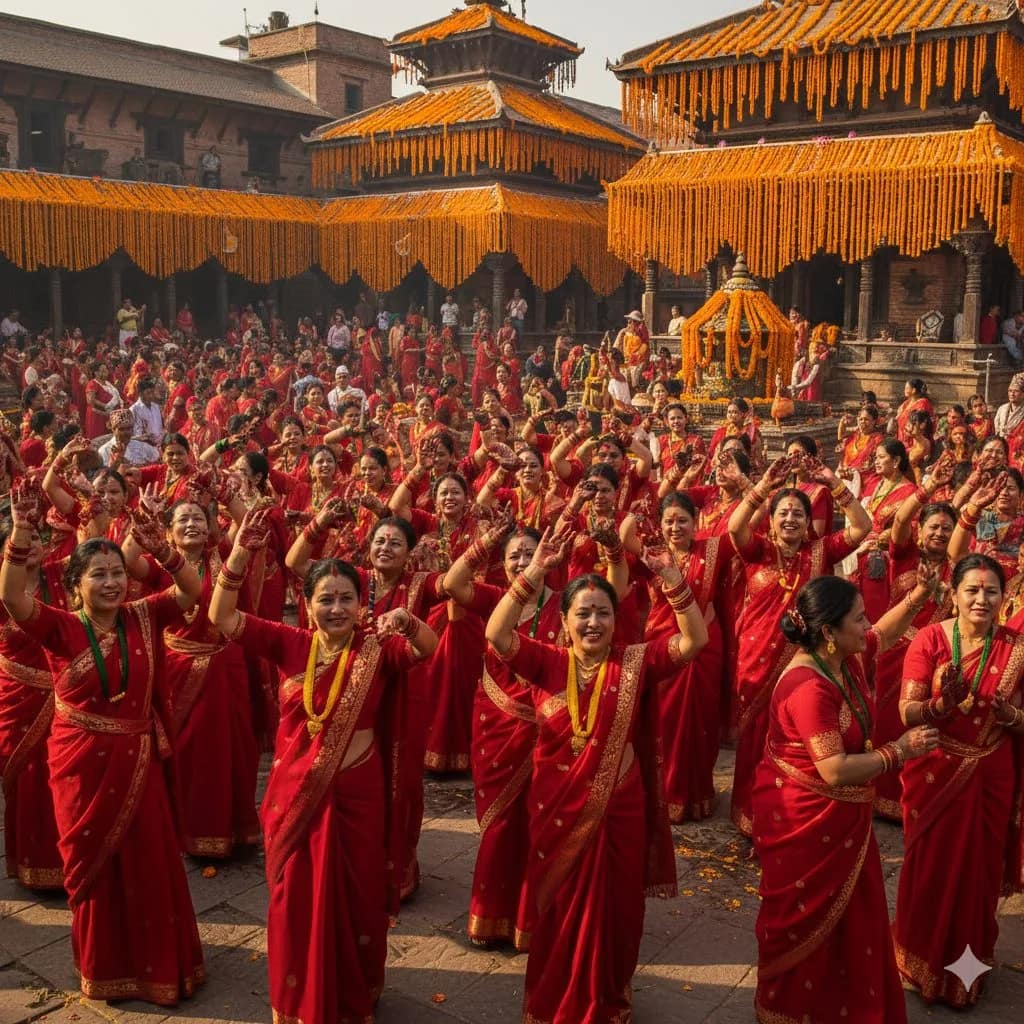
Teej is mainly a women’s festival, but as a trekker, you’ll still feel its impact if you’re hanging around Nepal during late August or early September. Women dress up in red saris, fast for their husbands’ long lives (yeah, it’s traditional like that), and there’s singing and dancing everywhere.
If you’re doing a monsoon trek, which honestly most people avoid because rain and leeches are nobody’s idea of fun, but some adventurous souls hit the Upper Mustang trek or Dolpo trek since those regions are in rain shadows, you might catch Teej celebrations in villages along the way. The energy’s different, more intimate and family-focused, but still beautiful.
The thing about monsoon trekking is everything’s insanely green and alive in a way you just don’t see during dry season. And if you time it with Teej, you get to see this whole other side of Nepali culture that most trekkers completely miss.
Indra Jatra (September) – Kathmandu’s Living Goddess Gets Paraded Around

This one’s more for people spending time in Kathmandu before or after their trek, but Indra Jatra is worth mentioning because it’s absolutely wild. The Living Goddess, this little girl they call Kumari, gets paraded through Kathmandu’s old city in a chariot, and there are masked dances, music, and general chaos in Durbar Square.
If you’re starting your Langtang trek, Helambu trek, or any trek launching from Kathmandu in September, definitely stick around for a day to catch Indra Jatra. It’s this perfect blend of ancient tradition and urban madness that somehow just works. You’ll see stuff that makes zero sense until your guide explains it, and even then you’re like “wait, what?”
The procession of the Kumari is surreal. This tiny kid dressed in elaborate makeup and costume, sitting perfectly still in a chariot while thousands of people lose their minds around her. It’s one of those things you can’t really explain, you just gotta see it.
Planning Your Trek Around Festivals – Real Talk Time
Here’s what you actually need to know: trekking during festivals is amazing, but it requires flexibility. Some tea houses shut down for a day or two. Trails get busier than usual. Transportation can be wonky because everyone’s trying to get home or to the next celebration. Your carefully planned itinerary? Yeah, it might need some adjusting.
But the trade-off? You get to see Nepal as it actually is, not just the sanitized trekker version. Share festival meals with families in mountain villages who invite you in like you’re long-lost relatives. You dance badly to traditional music after hiking eight hours uphill. You get blessed by village elders who don’t speak a word of English but somehow make you feel like you belong there.
Whether you’re planning an Everest Base Camp trek, Annapurna Circuit, Manaslu Circuit, Upper Mustang trek, Langtang Valley trek, or any other high-altitude adventure in the Himalayas, timing it with a festival adds this whole extra layer to the experience that you just can’t get any other way.
The mountains? They’re not going anywhere. They’ll still be massive and mind-blowing whenever you show up. But the festivals? They’re these brief, explosive moments when centuries of tradition come alive, and you get to be part of it, even if just for a few days.
So Which Season Actually Wins for Festival Trekking?
Look, if someone’s forcing you to pick just one season, autumn takes the crown. No argument. September to November dumps Dashain, Tihar, and Mani Rimdu all in your lap at once, plus the weather’s stupid perfect. Monsoon just wrapped, skies are crazy clear, and temps are in that sweet spot where you’re not melting in the valleys or freezing your ass off at altitude. Every tea house is open, every pass is good to go, and mountain views that’ll wreck your camera roll. Annapurna Circuit? Everest Base Camp? Manaslu? All absolutely insane during autumn. Yeah, trails are busier, but everyone’s vibing because weather’s cooperating and festivals are popping off everywhere.
Here’s the real deal though. Mountains aren’t leaving. Everest’s gonna sit there being massive whether you show up this year or next decade. But festivals? Those brief explosive moments when centuries-old traditions come alive and you’re actually part of it, not just watching from the sidelines? That’s when Nepal stops being a checkbox destination and starts feeling like somewhere you kinda get, even just a little. The music, the colors that hurt your eyes in the best way, entire villages coming together for stuff that’s been happening since forever.

